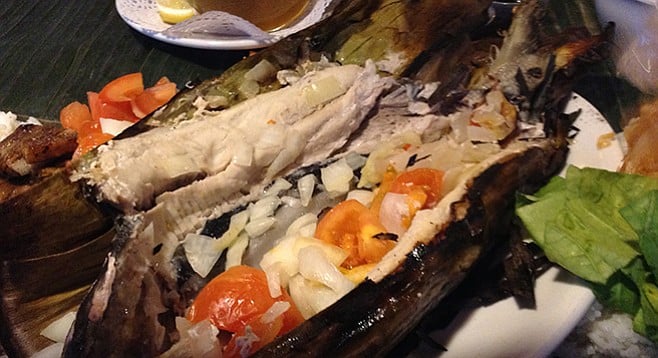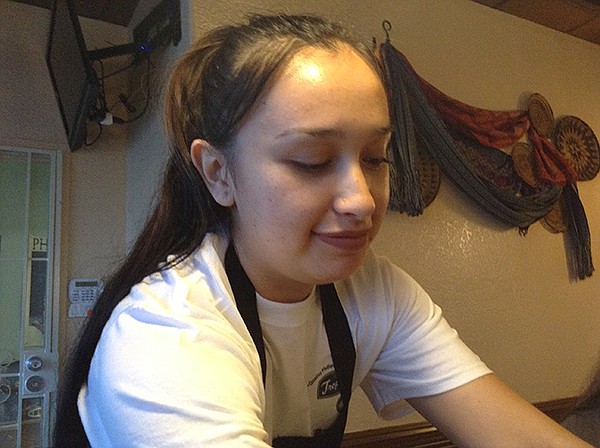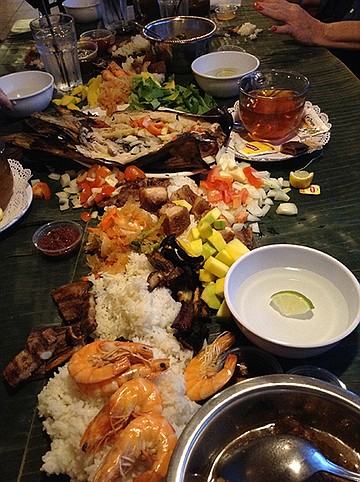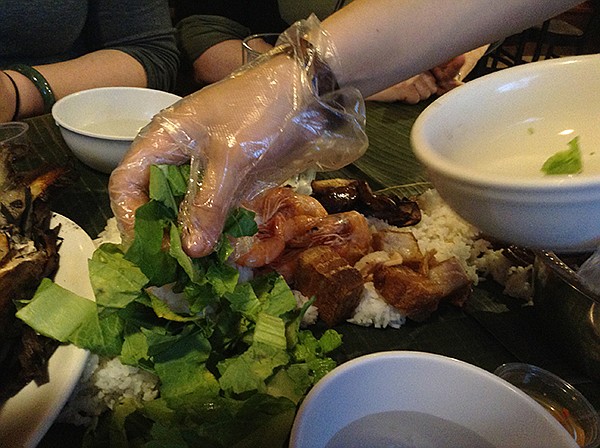 Facebook
Facebook
 X
X
 Instagram
Instagram
 TikTok
TikTok
 Youtube
Youtube

“With your fingers, dude?” says Wes.
“Hey, what else did people eat with, before you French brought in the fork, right? You invented cutlery! The Curse of the Eating Classes!”
Actually, Wes has always been a Freedom Fries kind of guy. But recently, DNA told him he’s got French in him. Heh heh!

We’re standing in Old Schoolhouse Square, in National City, in the middle of what you might call Little Manila, outside a Tudor-looking place called Villa Manila. Waiting for the others to turn up.
“You mean, food’s slopped right on the table? No plates?”
“No knives, no forks, no plates. Banana fronds, dude. They are the plates. It’s a feast. Kamayan!”
The word “Kamayan” actually means to eat “by hand.” Filipinos have been gathering like this since the beginning of time (and doing it here in California just about as long: They first landed here in — can you believe? — 1587, jumping ship from Spanish treasure galleons.)
Wes is still skeptical, but by now the rest of the crowd has rolled up, and we’re rolling in. Six of us: Wes, me, Katie, Marie, Margaret, Missie. Because with a Kamayan, you’ve got to have at least four, but six is better.

“You can use cutlery,” says Diana, the receptionista, “but most Filipinos like eating with their hands when it comes to feasting. It’s a tradition. It ties them to the old ways.”
We sit down at this long table covered in banana fronds, cut table-napkin size. One thing that’s probably just as well: no booze. But they do have ube milkshakes ($5.50). Ube’s made from the purple water yam, says Wes, who knows these things. Then he and Margaret get a sample of the pandanus drink ($4.50), which somehow has a nutty taste that Wes says “just speaks Asia” to him. So, everybody goes for that.

This is when the procession of food starts. And yes, it’s a little shocking to see Diana scoop up food in her plastic glove-covered hand, from rice to salads to meat stews, and splot them down on the banana leaves. Inihaw na baboy — grilled pork, — halabos na hipon — shrimp steamed in lemon soda and garlic, chili and pork in coconut sauce, grilled eggplant, a salad of mustard leaves, lechon kawali — deep-fried pork belly, salted preserved ducks’ eggs, steamed rice, pickled cabbage, adobo (chicken and pork stew), mustard leaf salad, and bangus — a splayed-out grilled milkfish, waiting to be picked at. Bangus is kind of the national fish of the Philippines. I google it. Has been swimming round since, wow, the cretaceous — like at least 100 million years — and they’re still doing well.

They call it Milkfish because when you cook it, the flesh turns as white as milk.
So, tentatively at first, everybody starts reaching out to drag pieces of meat or salad or fish or rice towards their part of the banana leaf, like cats when their owners aren’t looking.
The fish gets an early rush. Someone mentions Finding Nemo.
“I am a nice shark, not a mindless eating machine,” quotes Wes as he reaches out for more.
“Righteous! Righteous!” says Margaret.
Missie (eating into what turns out to be the deeply-salted duck egg): “Oh, my stomach. Oooh.”
Wes: “Hey, no hurling on the shell, ok? Just waxed it.”
Marie: “Oh man. Can’t face those shrimp. Little black eyes looking up at you. What next?”
Margaret: “Just keep swimming. Just keep swimming. Just keep swimming.”
I’m trying the egg. Hmm. Reminds you of the classic 100-year-old eggs. Man, duck dee-licious.
And the steamed shrimp? Yes, you’ve got to avoid looking at the black eyes on sprouts as you slide the little guy into your maw — and you’ve also got to slide out pieces of shell from between your teeth. It’s still worth it.
Nobody’s shy no mo’. They’re grabbing at the grilled pork, the chili and pork in coconut sauce, the grilled eggplant, the adobo of chicken and pork, and specially the deep-fried pork belly. The good news: there’s enough for all. Me, I love the pawk belly, natch, but also the Bicol Express — chili and pork in coconut sauce. Plus, hey, the eggplant, and the not-quite ripe (that’s how they’re supposed to be) mangos. The pickled cabbage is fine.
Even the rice has its place, separating flavors before you grab each new thing from the pile.
To spice things up, they have bagoong, fermented fish sauce, and also a bottle of Mang Tomas, the Filipino pork liver sauce. (“Mang” is an honorific, a bit like the Spanish “Don Tomas”). It’s great for the lechon pork.
Plus, the atmosphere around you makes you kinda feel up. Table next door, with 16 people, breaks out into “Happy birthday.” Ten minutes later, the next table starts singing the same. Kids run around excitedly. Grandparents sit enjoying the living proof of their success in life.
The “Fiesta” costs $95. Then you subtract $15, because Thursday is “Happy Hour” for Kamayan, then add drinks, tax, tips. Total comes to around $115 for us six. Say twenty bucks each. (Could have had the “Salo-Salo” menu at $65 (Salo-Salo means banquet in Tagalog), but it only serves four people.
We say Salamat po — Thank you — to Diana, and head out. Hands still a touch sticky. But grease on the palm? A small price to pay to get back to the Filipino future.
The Place: Villa Manila, 500 East 8th Street, National City, 619-477-8512
Hours: 11am-9pm, Tuesday to Thursday; 11am–10pm, Friday, Saturday; 11am-8pm, Sundays; closed Mondays
Prices: Kamayan pre-set menus include Salo-Salo (“Banquet,” 8 dishes, for up to four people), $65; Fiesta (12 dishes, serves up to six people), $95; Seafood (12 dishes including crab, milkfish, tilapia, shrimp, mussels, squid), $125; Barkada (“shipload of friends”), 14 dishes including whole tilapia, longanisa, pancit, crispy calamari, okra, preserved eggs), $125; regular menu items include crepe-style lumpia (fried egg rolls), $6.95; Lomi (shrimp, pork, chicken in egg noodle soup), $9; lechon kawali (crispy pork belly), $12.95; dinaguan (stewed pork in blood gravy), $11.95; ampalaya con carne (bitter gourd with sirloin beef), $10.95; fried rice, $4.50
Buses: 929, 955, 967, 968
Nearest Bus Stops: 8th and E (929, 955, westbound); 8th and F (929, 955, eastbound); 8th and D (967, 968, westbound); 7th and D (967, 968, eastbound)


“With your fingers, dude?” says Wes.
“Hey, what else did people eat with, before you French brought in the fork, right? You invented cutlery! The Curse of the Eating Classes!”
Actually, Wes has always been a Freedom Fries kind of guy. But recently, DNA told him he’s got French in him. Heh heh!

We’re standing in Old Schoolhouse Square, in National City, in the middle of what you might call Little Manila, outside a Tudor-looking place called Villa Manila. Waiting for the others to turn up.
“You mean, food’s slopped right on the table? No plates?”
“No knives, no forks, no plates. Banana fronds, dude. They are the plates. It’s a feast. Kamayan!”
The word “Kamayan” actually means to eat “by hand.” Filipinos have been gathering like this since the beginning of time (and doing it here in California just about as long: They first landed here in — can you believe? — 1587, jumping ship from Spanish treasure galleons.)
Wes is still skeptical, but by now the rest of the crowd has rolled up, and we’re rolling in. Six of us: Wes, me, Katie, Marie, Margaret, Missie. Because with a Kamayan, you’ve got to have at least four, but six is better.

“You can use cutlery,” says Diana, the receptionista, “but most Filipinos like eating with their hands when it comes to feasting. It’s a tradition. It ties them to the old ways.”
We sit down at this long table covered in banana fronds, cut table-napkin size. One thing that’s probably just as well: no booze. But they do have ube milkshakes ($5.50). Ube’s made from the purple water yam, says Wes, who knows these things. Then he and Margaret get a sample of the pandanus drink ($4.50), which somehow has a nutty taste that Wes says “just speaks Asia” to him. So, everybody goes for that.

This is when the procession of food starts. And yes, it’s a little shocking to see Diana scoop up food in her plastic glove-covered hand, from rice to salads to meat stews, and splot them down on the banana leaves. Inihaw na baboy — grilled pork, — halabos na hipon — shrimp steamed in lemon soda and garlic, chili and pork in coconut sauce, grilled eggplant, a salad of mustard leaves, lechon kawali — deep-fried pork belly, salted preserved ducks’ eggs, steamed rice, pickled cabbage, adobo (chicken and pork stew), mustard leaf salad, and bangus — a splayed-out grilled milkfish, waiting to be picked at. Bangus is kind of the national fish of the Philippines. I google it. Has been swimming round since, wow, the cretaceous — like at least 100 million years — and they’re still doing well.

They call it Milkfish because when you cook it, the flesh turns as white as milk.
So, tentatively at first, everybody starts reaching out to drag pieces of meat or salad or fish or rice towards their part of the banana leaf, like cats when their owners aren’t looking.
The fish gets an early rush. Someone mentions Finding Nemo.
“I am a nice shark, not a mindless eating machine,” quotes Wes as he reaches out for more.
“Righteous! Righteous!” says Margaret.
Missie (eating into what turns out to be the deeply-salted duck egg): “Oh, my stomach. Oooh.”
Wes: “Hey, no hurling on the shell, ok? Just waxed it.”
Marie: “Oh man. Can’t face those shrimp. Little black eyes looking up at you. What next?”
Margaret: “Just keep swimming. Just keep swimming. Just keep swimming.”
I’m trying the egg. Hmm. Reminds you of the classic 100-year-old eggs. Man, duck dee-licious.
And the steamed shrimp? Yes, you’ve got to avoid looking at the black eyes on sprouts as you slide the little guy into your maw — and you’ve also got to slide out pieces of shell from between your teeth. It’s still worth it.
Nobody’s shy no mo’. They’re grabbing at the grilled pork, the chili and pork in coconut sauce, the grilled eggplant, the adobo of chicken and pork, and specially the deep-fried pork belly. The good news: there’s enough for all. Me, I love the pawk belly, natch, but also the Bicol Express — chili and pork in coconut sauce. Plus, hey, the eggplant, and the not-quite ripe (that’s how they’re supposed to be) mangos. The pickled cabbage is fine.
Even the rice has its place, separating flavors before you grab each new thing from the pile.
To spice things up, they have bagoong, fermented fish sauce, and also a bottle of Mang Tomas, the Filipino pork liver sauce. (“Mang” is an honorific, a bit like the Spanish “Don Tomas”). It’s great for the lechon pork.
Plus, the atmosphere around you makes you kinda feel up. Table next door, with 16 people, breaks out into “Happy birthday.” Ten minutes later, the next table starts singing the same. Kids run around excitedly. Grandparents sit enjoying the living proof of their success in life.
The “Fiesta” costs $95. Then you subtract $15, because Thursday is “Happy Hour” for Kamayan, then add drinks, tax, tips. Total comes to around $115 for us six. Say twenty bucks each. (Could have had the “Salo-Salo” menu at $65 (Salo-Salo means banquet in Tagalog), but it only serves four people.
We say Salamat po — Thank you — to Diana, and head out. Hands still a touch sticky. But grease on the palm? A small price to pay to get back to the Filipino future.
The Place: Villa Manila, 500 East 8th Street, National City, 619-477-8512
Hours: 11am-9pm, Tuesday to Thursday; 11am–10pm, Friday, Saturday; 11am-8pm, Sundays; closed Mondays
Prices: Kamayan pre-set menus include Salo-Salo (“Banquet,” 8 dishes, for up to four people), $65; Fiesta (12 dishes, serves up to six people), $95; Seafood (12 dishes including crab, milkfish, tilapia, shrimp, mussels, squid), $125; Barkada (“shipload of friends”), 14 dishes including whole tilapia, longanisa, pancit, crispy calamari, okra, preserved eggs), $125; regular menu items include crepe-style lumpia (fried egg rolls), $6.95; Lomi (shrimp, pork, chicken in egg noodle soup), $9; lechon kawali (crispy pork belly), $12.95; dinaguan (stewed pork in blood gravy), $11.95; ampalaya con carne (bitter gourd with sirloin beef), $10.95; fried rice, $4.50
Buses: 929, 955, 967, 968
Nearest Bus Stops: 8th and E (929, 955, westbound); 8th and F (929, 955, eastbound); 8th and D (967, 968, westbound); 7th and D (967, 968, eastbound)
Comments